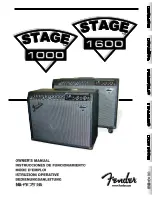
-6-
Making Connections to the HCA-1201A
Refer to Drawing on Page 4
Leave the AC cord disconnected before making any signal or speaker connections. When making
connections to the amplifier, make sure there is no strain or tension on the input leads, speaker wires, or
AC cord that could cause them to pull loose.
Unbalanced Input
Connect the unbalanced outputs of your preamplifier to the RCA input jack. With this connection, the
HCA-1201A's output is non-inverted; a positive signal at the input results in a positive signal at the
output.
XLR Input Connections
If your preamplifier is equipped with balanced XLR output connectors, you can use these connections
as an alternative to the RCA jacks. The industry standard pin assignment for the HCA-1201A's XLR input
connector is Pin 1: Ground, Pin 2: Positive (+), and Pin 3: Negative
(—)
.
Input Selector Switch
Once you have decided which input connectors you will use, set the input selector switch accordingly
to the Unbalanced or Balanced position.
Speaker Connections
You may connect bare wire up to AWG 12, speaker wire terminated with 1/4" spade lugs, or banana plugs
to the five-way binding posts of your power amplifier. If you use bare wire without terminals, make sure
you remove only enough insulation so the wire can fit through the hole that runs sideways through the
terminal’s binding post. Before inserting the wire, twist all its strands tightly to prevent strays that could
cause a short circuit. (You may want to "tin" the stripped wire with solder to prevent it from fraying and
oxidizing.)
Observing Correct Polarity
When you connect speakers to your amplifier, you will notice that one side of the two conductor speaker
wire will have some sort of mark: either printing, a raised ridge on the insulation, or a different color of
conductor to let you know which wire to connect to the positive and which to the negative speaker
terminals so you can repeat the connection on the power amplifier's binding posts.
Minimum Speaker Impedance Precautions
Although the HCA-1201A is capable of driving speakers with occasional impedance dips well below
2
Ω
, it is primarily designed to drive loudspeakers with a 4
Ω
or 8
Ω
nominal impedance. This is because
sustained high power operation into loads of less than 4
Ω
may cause overheating and subsequent thermal
shutdown.




























